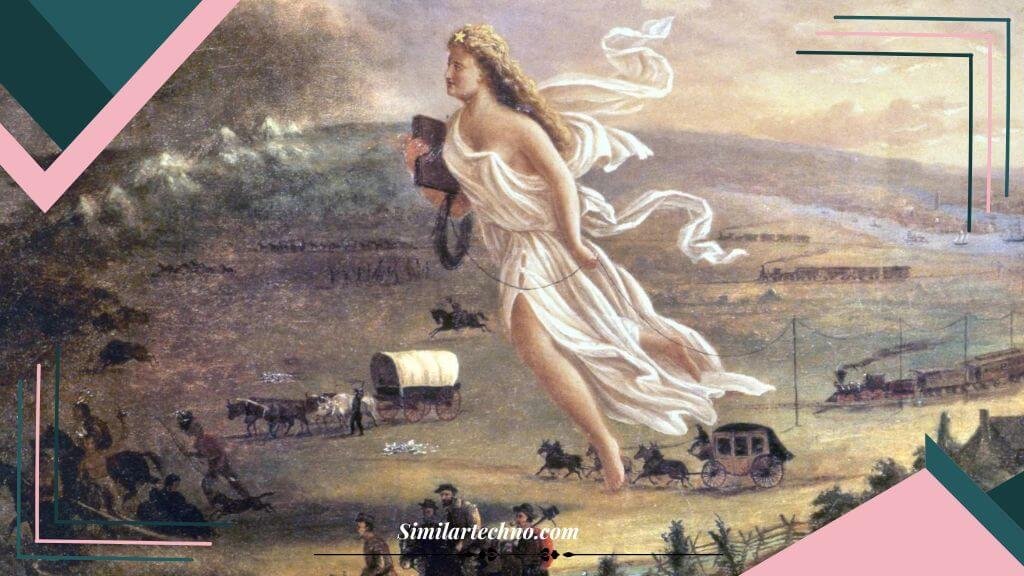The Manifest Destiny painting has always fascinated me, not just as a piece of art but as a window into a pivotal moment in American history. I first encountered this iconic image years ago, and it struck me how it perfectly captures the belief that the United States was destined to expand across the continent. The painting shows Columbia, a symbolic figure leading settlers westward, filled with optimism and the promise of new frontiers. As I explored it further, I realized how this painting symbolizes more than just westward expansion—it embodies a time when the nation’s identity and purpose were being shaped. Its history continues to stir discussions, making it more than an artwork.

History Behind the Manifest Destiny Painting
The Manifest Destiny painting was created by the artist John Gast in 1872. John Gast was an American artist and lithographer known for depicting themes related to American expansion. He painted this piece when the idea of Manifest Destiny was widely accepted, and the United States was rapidly moving westward. The painting reflects the growing sense of nationalism and the belief that America’s duty was to expand across the continent. Created in the post-Civil War era, the Manifest Destiny painting captures the spirit of the 19th century, a time of significant social and political change. The painting was an artistic expression and a tool to promote the idea of westward expansion and the country’s future role. Its timing was crucial in how Americans viewed their mission during this transformative historical period.
Themes in the Manifest Destiny Painting
The Manifest Destiny painting presents several key themes that reflect the beliefs of the time. One central theme is westward expansion, shown through the image of Columbia, a symbolic female figure leading settlers toward the untamed West. The painting also represents progress, civilization, and the spread of American ideals, as Columbia is depicted bringing light and order to the frontier. Another theme is the idea of the nation’s divine right to expand, with the settlers confidently moving forward. The Manifest Destiny painting illustrates the American belief in Manifest Destiny by showing the movement of people toward new territories. This movement is presented as inevitable and righteous, with the figure of Columbia symbolizing the belief that it was the country’s mission to conquer and civilize the land, justifying the expansion of the United States across the continent.
Read More: Monster Hunter Wilds: Conquer the Wilderness 2025
Symbolism
Several symbols in the Manifest Destiny painting help tell the story. For example, the figure of Columbia, holding a light and moving westward, symbolizes the spread of knowledge and civilization. The painting also shows Native Americans and animals being pushed aside, symbolizing the impact of expansion on the land and its original inhabitants.
The Role of the Painting in American History
The Manifest Destiny painting played a significant role in shaping how people thought about American expansion. It was used to justify moving west and taking over land. The painting showed that the United States was destined to expand, encouraging many to support the westward movement. It also reflected the belief that American culture and society were superior.
The Painting’s Influence on Popular Culture
Over time, the Manifest Destiny painting became an important symbol in American history. It has been featured in books, films, and even political cartoons. The image of Columbia leading the way to the West is still used today to represent the idea of American expansion. The painting has influenced how people think about the country’s growth and its impact on the land and people already living there.
Criticism of the Manifest Destiny Painting
Not everyone agrees with the ideas shown in Manifest Destiny art. Some critics argue that the painting overlooks the harm caused by the expansion. Native Americans and other groups were displaced and forced to move, which the painting doesn’t fully show. Today, some people view the painting as a symbol of the adverse effects of Manifest Destiny, such as the loss of land and rights for indigenous people.
Read More: Eggs Recalled Salmonella: Protect Your Health Now 2025
Impact on Art and Artists
The Manifest Destiny painting had a significant impact on other artists. It influenced how artists viewed the country’s growth and its global role. The painting used Romanticism, which focused on idealizing nature’s beauty and the nation’s power. Other artists also used this style to depict the growing United States.
Manifest Destiny Painting in Modern Times
Today, the Manifest Destiny painting is still essential. It’s often discussed in history classes to teach about the United States’ expansion and its consequences. Many see it as a reminder of the past and how ideas about the country’s mission have shaped history. It’s also a tool for understanding how art can reflect the beliefs and attitudes of a specific period.
FAQs
Who painted Manifest Destiny art?
The Manifest Destiny painting was created by John Gast in 1872.
What does the Manifest Destiny painting symbolize?
The painting symbolizes the belief in American expansion across the continent.
What is depicted in the Manifest Destiny painting?
The painting shows a woman representing Columbia leading settlers westward, symbolizing civilization and progress.
How did the Manifest Destiny painting influence American history?
It reinforced the idea that the United States had a divine right to expand westward.
Is the Manifest Destiny painting controversial?
Yes, it is criticized for ignoring the negative impacts on Native Americans and other groups.
Conclusion
In conclusion, the Manifest Destiny painting symbolises the hopes and challenges that defined America’s westward expansion. Reflecting the belief that the nation was destined to stretch across the continent, it captures the optimism and ambition of the time. However, as we’ve seen, it also overlooks the problematic truths of displacement and conflict faced by Indigenous people and other groups during this period. While the painting continues to hold historical significance, it also serves as a reminder of the complexities of American expansion. The Manifest Destiny painting has always been more than just art; it reflects the country’s growth, ideals, and long-lasting impact on those who lived on the land long before settlers arrived.




